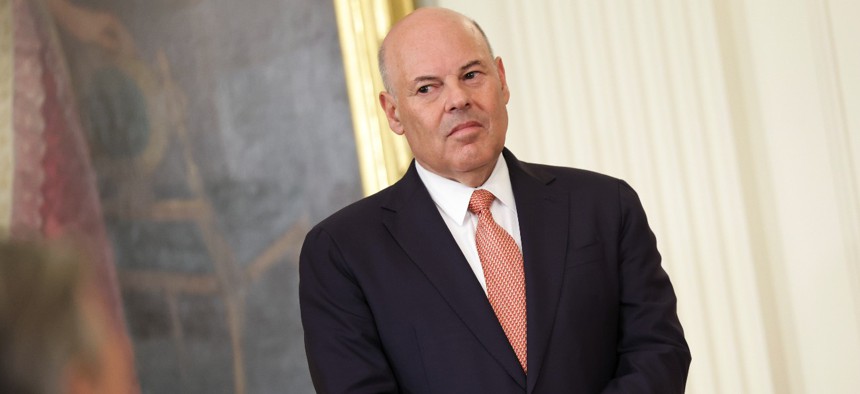
Postmaster General Louis DeJoy said: “We are staking out our position and going for it. That means change. Change for everyone. Our need to change is obvious, necessary and an important step in our transformation.” Kevin Dietsch/Getty Images
The Postmaster General Tells USPS Employees to Keep Upcoming Workforce Changes ‘in Perspective’
DeJoy says it is a "fool's errand" to try to predict all the changes postal workers will face in the coming years.
The U.S. Postal Service is asking employees to remain flexible and forward thinking as it adapts to whatever reforms may come ahead, saying changes such as longer commutes will serve the interest of the organization.
As USPS prepares to roll out its plan to consolidate some operations away from post offices and into larger facilities, Postmaster General Louis DeJoy has delivered a message to employees to think of the efficiencies for the agency ahead of their own inconveniences. He also stressed that employees will report to nicer buildings with improved equipment, making their work days more pleasant overall.
“I realized that change is never easy, so I don't want to minimize it,” DeJoy said in a recent video message for all employees. “However, I do ask you to put the changes that might impact you in perspective since I can assure you that the changes we are proposing are vitally necessary, and will significantly improve the long term prospects for the Postal Service as a great American institution.”
The changes, expected to begin at a select few pilot facilities this month, will mean letter carriers no longer go to their local facility to pick up mail for their route, instead traveling farther distances after starting at a consolidated location. The impacted post offices will still conduct their retail operations, but a lot of the back-end functions will be stripped away and relocated. Many clerks will have to relocate to new facilities and some postmasters could be out of a job or forced to find a new one.
“For some of you, this might mean you have to travel a little further to get to work,” DeJoy said. “But when you get there, you will have nicer facilities and better equipment, and you will be personally contributing to the transformation of the United States Postal Service.”
The postmaster general said USPS must adapt to the evolving market and his reforms will lead to greater productivity and efficiency. He added no entity can survive without improving productivity.
“We are staking out our position and going for it,” DeJoy said. “That means change. Change for everyone. Our need to change is obvious, necessary and an important step in our transformation.”
DeJoy cautioned, however, that he cannot guarantee the shape that every aspect of the transition will take.
“Trying to predict every change we will make along the way is a fool’s errand,” he said.
One letter carrier in Cincinnati told Government Executive she and her colleagues would embrace the changes—including the longer commutes—if it was actually proven to cut costs, but employees have doubts that paying them more to drive longer actually will lead to efficiencies. DeJoy has said it will save costs on the contracted trucks that USPS hires to bring mail between various facilities. With the routes taking longer as letter carriers travel further, management has told various groups it will have to add some new staff.
“We are paid by the hour,” the letter carrier said. “If it takes us longer, that costs the Postal Service money.” She added if carriers are pressured to complete their routes in the same amount of time despite the longer drives, “that could start some tension.”
Postal management has in recent weeks ramped up its communication with employee groups, but leaders for those organizations said their questions about the impact of the changes on their members have largely gone unanswered. USPS officials have not shared or made public the data underlying their assumptions of cost savings. Inspector general reports have found previous consolidation initiatives have realized just a small fraction of projected savings, though DeJoy has stressed his renewed effort will bring about more benefits than just lowered costs.
DeJoy suggested he has already vastly improved the trajectory for the USPS workforce. Previous leadership had overseen a significant workforce reduction, increased outsourcing, declined to invest in infrastructure and hired far more non-career workers who often quickly left the agency. While DeJoy has said he could further cut 50,000 postal positions through attrition, he noted that he has converted 100,000 non-career employees into permanent staff. He said USPS will continue to bring in new equipment to improve working conditions and vowed to expand offerings such as same-day delivery, return services and initiatives like the highly successful delivery of COVID-19 test kits to households throughout the country.







